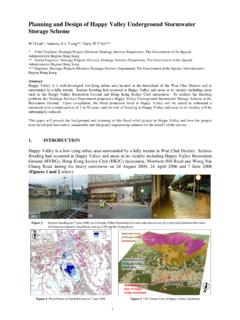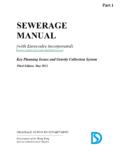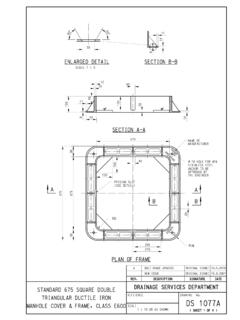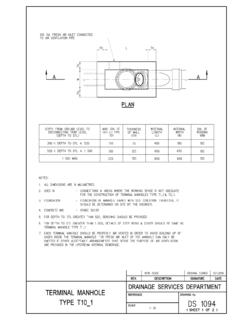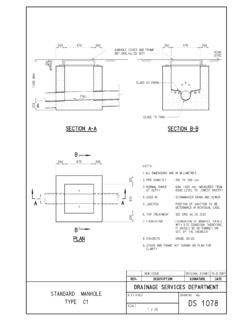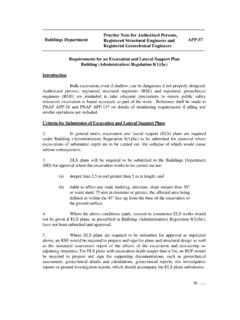Transcription of A CASE STUDY: DESIGN AND CONSTRUCTION OF …
1 27 The State-of-the-art Technology and Experience on Geotechnical Engineering in Malaysia and hong KongWednesday, 25 February 2009A CASE STUDY: DESIGN AND CONSTRUCTION OF FOUNDATION AND BRACED EXCAVATION AT A RECLAIMED SITE AT WATERFRONTR upert KY Leung Hyder Consulting LtdDr Eric SF LiHyder Consulting LtdCheuk-lun LeungDrainage Services Department, hong kong SAR GovernmentAbstract: The Sheung Wan Stormwater Pumping Station is located on reclaimed land at the waterfront of Victoria Harbour. It comprises a pump house and an underground storage tank measuring by 43m on plan and 11m deep as temporary stormwater storage for alleviating the flooding problem of Sheung Wan Area. The presence of heterogenous marine deposits and dumped fill, the proximity to the vertical seawall and sensitive structures, and the recharge from the sea has posed particular difficulties to the DESIGN and CONSTRUCTION of the temporary excavation.
2 Also, an alternative foundation DESIGN using a combination of prebored socketed H-piles, minipiles and raft foundation has been adopted to replace the large diameter bored piles in the conforming DESIGN . This paper presents the challenges faced in the DESIGN of the foundation and the temporary excavation and how they are addressed. It also describes the difficulties encountered in the CONSTRUCTION of foundation and braced excavation and the solutions adopted to overcome lowlying Sheung Wan areas at the western side of hong kong Island has long been plagued by flooding during heavy rainstorms coincided with high tide. The situation would be worst during extreme high tides, when the sea level is higher than the ground level in Sheung Wan, causing seawater to flow back and overflow from manholes and gully gratings.
3 A stormwater pumping station was proposed by the Drainage Services Department of the hong kong SAR Government at the waterfront of Sheung Wan. The CONSTRUCTION was commenced in mid 2006 and is to be completed in 2009. It serves to collect stormwater from a network of drains and discharge the water into the harbour through high-powered submersible pumps, at the same time stopping the backward flow of seawater into the drainage system by a penstock. One key element of the project was the foundation CONSTRUCTION for the Sheung Wan Stormwater Pumping Station (the SWSPS ). The pile caps of the pumping station are found at various depths, with the lowest one the pile cap for the underground storage tank, which serves also as the base slab of the tank founding at some 11m below the existing ground surface.
4 To construct the pile caps, it was necessary to first install an excavation and lateral support (ELS) system. 28A Case Study: DESIGN and CONSTRUCTION of Foundation and Braced Excavation at a Reclaimed Site at WaterfrontThe pumping station is located on reclaimed land and is just 11m from the harbour. The heterogenous nature of the dumped fill forming the reclamation, the proximity to the vertical seawall part of the pumping station is located above the foundation of the seawall, the constant recharge from the sea, the proximity of Water Supplies Department s Sheung Wan Salt Water Pumping Station a structure on raft foundation, all posed challenges to the DESIGN and CONSTRUCTION of foundation and excavation for the pumping authors of this paper were involved in the DESIGN of the foundation, the DESIGN of the ELS and the supervision of the CONSTRUCTION LOCATIONThe proposed SWSPS is located along Chung kong Road, Sheung Wan, hong kong .
5 The footprint area of the pumping station structures measured approximately 56m long and 43m wide, whereas the ground level is approximately +4mPD. The SWSPS is surrounded by various structures, which are sensitive to ground movement. To the north is a vertical seawall, which was completed around 1976. The seawall, constructed of modular mass concrete blocks, was founded on a submerged bund formed by sand fill and rock fill. To the west of the SWSPS is the existing Sheung Wan Salt Water Pumping Station. The Salt Water Pumping Station is founded on raft footing and has a deep open culvert (founded at ) on the side abutting the proposed SWSPS. At the nearest point, this culvert is only approximately from the site boundary (4m from the SWSPS structure).
6 On the southern boundary is Chung kong Road where several major utilities pipes are present. On the opposite side of Chung kong Road is the Sheung Wan Waterfront Police Station, which is founded on piles. The Police Station is approximately 20m from the site boundary of the SWSPS. The eastern side is an open space for temporary site offices and material storage. Immediately prior to CONSTRUCTION , the Site was an open bazaar and was also used as parking 1: Location Plan of Sheung Wan Stormwater Pumping Station29 The State-of-the-art Technology and Experience on Geotechnical Engineering in Malaysia and hong KongWednesday, 25 February 2009 GROUND CONDITIONSA ccording to the geological survey map published by the Geotechnical Control Office, the site is underlain by fill material generally reclaimed in 1982 which possibly overlies medium grained granite formed in the Jurassic-Cretaceous period of the Mesozoic era.
7 The ground investigations for this project revealed that superficial deposits comprising fill, marine deposits and alluvium are overlying weathered granite with saprolitic zone before reaching the rockhead of strong moderately to slightly decomposed granite. Figure 2 presents a typical geological section across the 2: Typical North-South Geological Section across the SiteSeries of ground investigations have been carried out at different periods, between May-July 2002 (6 holes), between February-March 2006 (26 holes) and during the early part of the contract in July and August 2006 as pre-drilling for the foundation piles (63 holes). Although the latest series of holes were excavated by wash boring, the drillholes were useful in understanding the rockhead profile at the summary of the strata as encountered during ground investigations is presented in Table Case Study: DESIGN and CONSTRUCTION of Foundation and Braced Excavation at a Reclaimed Site at WaterfrontTable 1 : Summary of Geological Strata at the Site Geological Description Stratum Fill Various types of Fill material including general fill, sand fill and rock fill, varying widely in composition in the forms of layers of sandy clayey SILT, sandy silty CLAY, silty CLAY, silty/clayey fine to coarse SAND, coarse GRAVEL and COBBLES and BOULDERS.
8 The thickness of the Fill encountered varied between and , with the base elevation of the it ranging from -11mPD to -28mPD. Relatively large cobbles or boulders were encountered by the drillhole series closest to the existing seawall on the SWSPS northern boundary, interpreted to be the foundation materials for the seawall based on review of the as-built records of the seawall. Marine Comprising soft to firm, sandy silty CLAY with occasional gravel and shell fragment was encountered underneath the fill at the portion of site surrounded by existing seawall. Locally, thin layers of anthropogenic mud are present within the deposits. The revealed thickness of the deposits ranges from 0m (for drillholes closest to the seawall) to 14m. It is believed that the presence/absence of the Marine deposits has been influenced by the recent past CONSTRUCTION in the vicinity.
9 From the as-built records of the seawall (see latter discussion), it is noted that the soft Marine deposits were required to be dredged before the backfill with rockfill and sand fill. Alluvium Encountered only in some drillholes underneath the Marine deposits. When encountered, it comprises firm, slightly sandy clayey SILT with occasional gravel. Alluvium was found to a depth of ( ) at the deepest location. Saprolite Saprolitic soil derived from the in-situ weathering of medium to coarse grained Granite. The material recovered comprises slightly sandy/sandy clayey SILT, silty SAND or fine to coarse SAND with fine gravel. The thickness of the saprolite encountered varies between and , with the base elevation ranging from to Corestones were encountered at some drillhole locations immediately beneath Alluvium at depths between 25m ( ) and 59m (-55mPD).
10 The corestones comprise weak to very strong, highly to slightly decomposed Granite. Bedrock Moderately or slightly decomposed predominantly medium to coarse grained Granite. The strength of rock encountered varies from moderately strong to very strong. Occasional pegmatitic dykes were encountered within the granitic rock mass. Drillholes were terminated at depths between 55m and 65m, with proven rock thickness varies from 5m to Corestone31 The State-of-the-art Technology and Experience on Geotechnical Engineering in Malaysia and hong KongWednesday, 25 February 2009 GROUNDWATER CONDITIONSS tandpipe and piezometers were installed in some of the drillholes at depths ranged from 19m to 23m below ground for groundwater level monitoring. As the site is close to the shoreline, the measured groundwater levels are found corresponded generally to the active seawater level which varies from + to + Piezometers were not installed at deeper depth closer to the rockhead level and there was no information to evaluate whether an artesian pore pressure are PROPERTIES OF SOILSE ngineering properties of various soil materials encountered by drillholes within the site have been determined using both field and laboratory test data where available, and are summarised in Table 2: DESIGN Engineering Properties of Soil MaterialsIn situ falling and constant head permeability tests were carried out in selected drillholes during the 2006 ground investigation.
